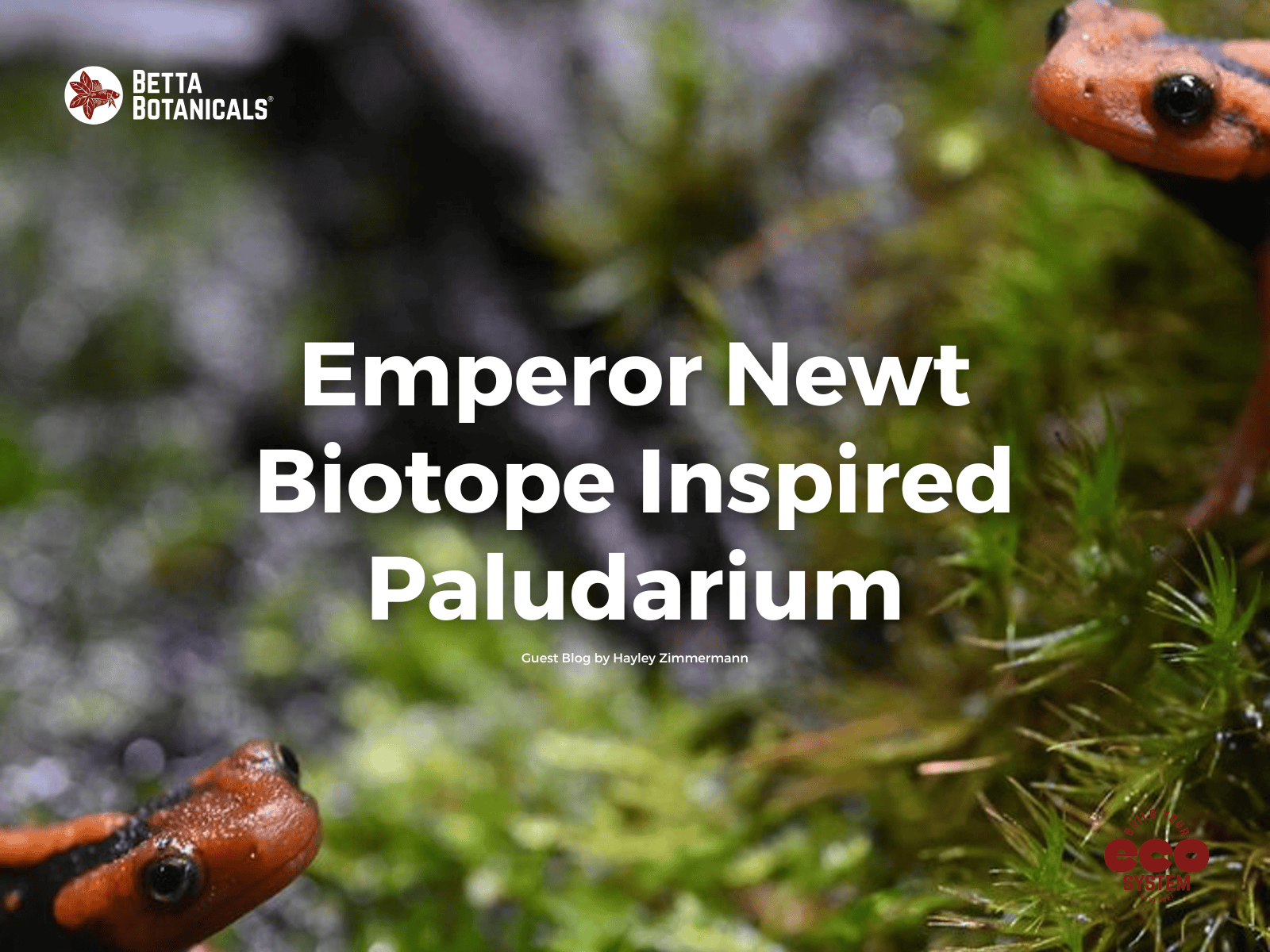How to Culture Flightless Fruit Flies for Aquarium Fish
Flightless fruit flies are an excellent live food source for many types of fish, especially in botanical method aquariums where the natural diet and behavior of fish are a point of emphasis to recreate. Culturing your own fruit flies can be both cost-effective and rewarding, and I've found that using NEHERP media makes the process even more efficient (take this from someone who procrastinated making them for 7 months and now can't make enough!). This blog post will guide you through the steps of culturing flightless fruit flies and feeding them to your fish, along with some tips and tricks to optimize the process. I've included some photos as well as links to our social media with some fun content to match all types of learning styles, so make sure to read and watch your way through this whole post.
Photo by ArtOfTint
Introduction to Botanical Method & Blackwater Aquariums
Botanical method aquariums are ecosystems that incorporate natural materials such as leaves, seed pods, and wood to create a more natural and enriching environment for aquarium fish. This methodology to fish keeping puts a focus on replicating natural habitats, promoting natural fish behaviors, and growing an ecosystem to foster natural foraging and feeding behaviors. Live foods, such as wingless fruit flies, are an ideal addition to the routine of keeping a botanical aquarium due to their nutritional value and promotion of natural foraging behaviors in fish. Their flightless characteristics also help maintain tranquility in the home... because why would anyone want MORE fruit flies during the summer?
Why Do We Use Flightless/Wingless Fruit Flies?
Flightless fruit flies, specifically Drosophila melanogaster, are popular among aquarium enthusiasts for several reasons:
- Nutritional Value: They are rich in protein (~18%) and other essential nutrients like sodium, magnesium, potassium, manganese, copper and iron.
- Ease of Culturing: Flightless varieties are easy to contain and breed in deli cups with premade media.
- Natural Feeding: They encourage natural hunting behaviors in fish, especially in those fish who are top water forages like betta fish. Unprocessed foods help to reset the gut microbiome and digestive tract which bettas are prone to have issues with.
NEHERP Media: The Ideal Culturing Medium
Now, I am partial to NEHERP (New England ) media is a pre-mixed, ready-to-use medium designed specifically for culturing fruit flies, but any home made recipe or other companies media will do. My favorite provides all the necessary nutrients for optimal fruit fly reproduction and growth, making the culturing process straightforward and hassle-free with additives to reduce mold and mites.
Step-by-step Guide to Culturing Flightless Fruit Flies
Materials Needed
- Flightless Fruit Fly Culture: Obtain a starter culture from a reputable supplier, local hobbyist, or local pet store.
- NEHERP Media: Available in bulk pre-mixed bags.
- Containers: Use vented plastic containers or mason jars with breathable lids.
- Excelsior or Coffee Filters: Provides surface area for flies to climb and lay eggs.
- Water: To hydrate the media.
- Vinegar: Fruit flies love vinegar and it helps condition the media for long term success.
- Brewers Yeast: stabilize the culture.
Step-by-Step Instructions
- Prepare the Containers: Clean and dry the containers thoroughly to prevent mold growth.
- Mix NEHERP Media: Follow the instructions on the pack to mix the media with water. Typically, it requires a 1/3c:1/2c ratio of media to water.
-
Add Media to Containers: Pour the recommended dry media into the bottom of the containers.

-
Add Water: Pour water over the media according to the direction on the bag.

-
Add Stabilizers: sprinkle brewers yeast and vinegar onto the media.

-
Add Excelsior or Coffee Filters: Place a handful of excelsior or a few coffee filters on top of the media. This provides a surface for the flies to lay their eggs. I prefer Excelsior media which NEHERP also provides.

-
Introduce Starter Culture: Gently tap the flies from your starter culture into the new container.

- Seal and Vent: Secure the lid on the container, ensuring it is ventilated. This can be achieved by using lids with fine mesh or making small holes covered with breathable material.
- Maintain the Culture: Keep the culture at room temperature, around 70-75°F (21-24°C). Check regularly for mold or mites and remove any affected media. I find that when my ecosystem garage hits 80 °F my cultures take off with new flies emerging in 7-10 days. At lower temps I get flies closer to 12-14 days.
- New Cultures: Make new cultures every 12-14 days to keep flies always on hand.
Harvesting Fruit Flies
- Timing: Cultures typically start producing new flies within 7-10 days.
- Method: To harvest, tap the container lightly to dislodge flies to the floor of the container, then remove the lid and tap gently into a secondary container or directly into your aquarium.
Feeding Flightless Fruit Flies to Aquarium Fish
Benefits of Live Feeding
- Stimulates Natural Hunting Behavior: Encourages fish to exhibit natural predatory instincts snatching bugs off of the water.
- Whole-Food Benefits: Many conventional fish foods have fillers or synthetic dies added to them which your fish would not be encountering in nature. Since the point of a botanical method aquarium is to replicate nature, live foods just make sesne.
- Digestive Health: Betta fish are prone to digestive issues such as bloat or bacterial overgrowth, and the feeding of bugs can help to reset the microbiome of your betta helping to support optimal health.

Feeding Instructions for Aquariums
- Harvest the Flies: Smack the top of the container to dislodge the flied. Then remove the lid and turn upside-down over another deli container of the same size. Gently smack or flick the side or top of the container to dislodge flies into the empty deli cup below. I do this until I have a couple teaspoons of flies.
- Introduce to Aquarium: Gently release a small number of flies onto the aquarium water surface. Start with a few and observe how quickly they are consumed. They will float around the water surface and congregate in small piles.
- Monitor Feeding: Ensure all flies are eaten to prevent excess waste in the tank.
Tips and Tricks for Successful Fruitfly Culturing
Maintaining Culture Health
- Regular Cleaning: Wipe down fly shelf to reduce the presence of mites or other bugs attracted to the smell of the media. I do this with water and isopropyl alcohol once per month.
- Avoid Overcrowding: Use multiple containers to prevent overcrowding and ensure sufficient space for reproduction. I am feeding 6 tanks and 2 frog vivariums so I have 9 cultures going. Three that are aging out which I use to make new cultures. Three that are primed and I am actively feeding from. and, Three that are culturing with new larvae present and pupae on the sides.
- Temperature Control: Keep cultures in a stable, warm environment to promote consistent and healthy growth.
- Cleaning Old Containers: Once the media has been consumed I will take boiling water and pour it into old cultures to sterilize everything. I then drain the water and discard into the trash can outside as old cultures will be VERY SMELLY. I rinse out the containers with soap and rinse with plenty of water before allowing to fully dry before continued use.
Enhancing Nutritional Value of Fruit Flies
- Supplemental Feeding: Always douse flies in a calcium supplement with a monthly vitamin boost when feeding frogs. For fish, you can just dump them right into the aquarium.

Troubleshooting Common Fruitfly Culture Issues
- Mold Growth: Ensure containers are well-ventilated and avoid over-hydrating the media. Brewers yeast and vinegar help to out compete mold.
- Mite Infestation: Regularly inspect cultures and replace cultures if mites are detected.
- Low Reproduction Rates: Check temperature levels, and ensure media is fresh and adequately hydrated.
@bettabotanicals See how I use wingless fruitflies? Very Demure. #bettabotanicals #buildyourecosystem #fruitflyculture #bioactive #aquariumfish ♬ Lavender Cappuccino - Muspace Lofi
Seems Overwhelming, But It's Easier Than Brine Shrimp!
Culturing flightless fruit flies is a straightforward and effective way to provide high-quality live food for fish in botanical method aquariums. By following the outlined steps and incorporating the tips and tricks provided, you can maintain a healthy and productive fruit fly culture, ensuring your fish receive the best possible nutrition. This not only enhances their health and coloration but also enriches their environment by promoting natural behaviors. Happy culturing and feeding! I'd love to see your live food setups - feel free to send me an email to info@bettabotanicals.com!









Inspire your friends:
Celebrating Diversity and Supporting LGBTQ+ Youth with Betta Botanicals' 2024 Pride Pack
Free Tank Decor! - Collecting Your Own Blackwater Aquarium Botanicals